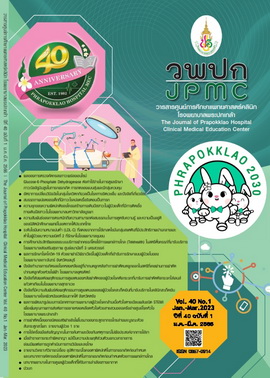Rate of Changing Diagnosis from Anxiety Disorders to Other Psychiatric Disorders and Associated Factors
Main Article Content
Abstract
BACKGROUND: Although anxiety disorders are common, anxiety may be a symptom of other psychiatric disorders such as schizophrenia, depressive disorders, and obsessive-compulsive disorder. Patients initially diagnosed with anxiety disorders may ultimately have an alternative diagnosis.
OBJECTIVES: To investigate the rate of changing diagnosis from anxiety disorders to other psychiatric disorders, factors associated with changing diagnosis, and types of new diagnosis.
METHODS: The study design was a retrospective chart review. In total, 1,578 patients diagnosed with anxiety disorders and who visited the Psychiatric OPD at Siriraj Hospital between 1 January 2017 and 31 December 2020 were included in this study.
RESULTS: The overall rate of changing diagnosis from anxiety disorders to other psychiatric disorders is 12.7%. The rates of changing diagnosis after the 1-year, 3-year, and 5-year follow-up of anxiety disorders are 7.2%, 10.4%, and 12.1%, respectively. According to the results of a logistic regression model, the factors associated with changing diagnosis are being a man, taking benzodiazepine medication, having no other psychiatric comorbidity, having no diagnosis of panic disorder, and not being in remission status for disorders. In the changing diagnosis group, anxiety disorders are mostly replaced by depressive disorders, bipolar disorders, or psychotic disorders.
CONCLUSIONS: It is important to consider another diagnosis in patients who present with anxiety and receive a diagnosis of anxiety disorders to plan appropriate treatments.
Article Details

This work is licensed under a Creative Commons Attribution-NonCommercial-NoDerivatives 4.0 International License.
References
American Psychiatric Association. Diagnostic and statistical manual of mental disorders. 5 th ed. Washington, DC: American Psychiatric Publishing; 2013.
Kittirattanapaiboon P, Tantirangsee N, Chutha W, Tanaree A, Kwansanit P, Assanangkornchai S, et al. Prevalence of mental disorders and mental health problems: Thai national mental health survey 2013. Nonthaburi: Department of Mental Health; 2016.
Bandelow B, Michaelis S. Epidemiology of anxiety disorders in the 21st century. Dialogues Clin Neurosci 2015;17:327-35.
Hall J. Schizophrenia - an anxiety disorder?. Br J Psychiatry 2017;211:262-3.
Goodwin GM. The overlap between anxiety, depression, and obsessive-compulsive disorder. Dialogues Clin Neurosci 2015;17:249-60.
Goodwin RD, Fergusson DM, Horwood LJ. Early anxious/withdrawn behaviours predict later internalising disorders. J Child Psychol Psychiatry 2004;45:874-83.
Schopman SM, Have MT, van Balkom AJ, de Graaf R, Batelaan NM. Course trajectories of anxiety disorders: results from a 6 year follow-up in a general population study. Aust N Z J Psychiatry 2021;55:1049-57.
Hovenkamp-Hermelink JH, Riese H, van der Veen DC, Batelaan NM, Penninx BW, Schoevers RA. Low stability of diagnostic classifications of anxiety disorders over time: a six-year follow-up of the NESDA study. J Affect Disord 2016;190:310-5
Bystritsky A, Khalsa SS, Cameron ME, Schiffman J. Current diagnosis and treatment of anxiety disorders. P T 2013;38:30-57.
Kessing LV, Willer I, Andersen PK, Bukh JD. Rate and predictors of conversion from unipolar to bipolar disorder: a systematic review and meta-analysis. Bipolar Disord 2017;19:324-35.
Gustavson K, Knudsen AK, Nesvåg R, Knudsen GP, Vollset SE, Reichborn-Kjennerud T. Prevalence and stability of mental disorders among young adults: findings from a longitudinal study. BMC Psychiatry [Internet]. 2018[cited 2020 Nov 7];18:65. Available from: https://www.ncbi.nlm.nih.gov/pmc/articles/PMC5848432/pdf/12888_2018_Article_1647.pdf
Scholten WD, Batelaan NM, Penninx BWJH, van Balkom AJLM, Smit JH, Schoevers RA, et al. Diagnostic instability of recurrence and the impact on recurrence rates in depressive and anxiety disorders. J Affect Disord 2016;195:185-90.
Park SC, Kim YK. Anxiety disorders in the DSM-5: changes, controversies, and future directions. Adv Exp Med Biol. 2020;1191:187-96.

